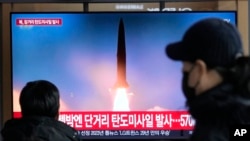North Korea's launch of a Hwasong-18 this week shows it may soon have a nuclear-capable intercontinental ballistic missile that can target any part of the United States, analysts say.
North Korean leader Kim Jong Un said Monday's test "of the most powerful ICBM" demonstrated the reliability of the country's nuclear strategic force. He added that Pyongyang will not hesitate to strike back if provoked, the state-run KCNA reported Thursday.
On Wednesday, U.S. B-1B and South Korean and Japanese fighter jets conducted joint aerial drills off the South Korean island of Jeju in what South Korea's Joint Chiefs of Staff described as a show of force in response to the ICBM test.
Monday's ICBM launch followed a test of a short-range ballistic missile (SRBM) the previous day, making this the third consecutive year to end with North Korean missile tests.
It was Pyongyang's fifth ICBM test of 2023 and third Hwasong-18 launch, following tests in April and July.
Ankit Panda, a senior fellow in the Nuclear Policy Program at the Carnegie Endowment for International Peace, said, "The Hwasong-18 program appears to now have transitioned into operational exercises, indicating that the missile may be closer to being commissioned formally into the country's strategic forces."
He said that aside from "minor modifications to the launcher, there doesn't appear to be anything technically novel about this latest missile, suggesting that they're looking to evaluate its performance under operational conditions."
The missile Kim lauded as "the most powerful" reached a maximum altitude of 6,000 km and traveled a distance of 1,000 km. Analysts said it could carry a nuclear warhead and if launched at a normal trajectory, its range could be over 15,000 km — far enough to reach any part of the United States.
However, that "doesn't necessarily mean that it is operational to the standard that we would hold," said David Schmerler, senior research associate who focuses on North Korea's nuclear and missile programs at the Middlebury Institute of International Studies at Monterey.
"As long as it doesn't blow up prior to launch, gets up in the air, and goes a certain distance," Pyongyang could consider the missile as working, he said. "But there are other things that go into it as well," such as whether it could reliably strike a far-distant target.
The day Pyongyang launched the ICBM, Pak Myong Ho, its vice minister of foreign affairs, held talks with Chinese Foreign Minister Wang Yi in China, according to Wang Wenbin, Chinese Foreign Ministry spokesperson.
South Korean Foreign Ministry spokesperson Lim Soo-suk called on China during a news briefing the next day to play a constructive role in persuading Pyongyang to end its destabilizing actions.
Robert Rapson, formerly charge d'affaires and deputy chief of mission at the U.S. Embassy in Seoul from 2018 to 2021, said while Beijing could rein in Pyongyang's missile program, it "chooses not to" because it does not see the missile launches as "a direct threat."
"Moreover, it serves Beijing's interest in the ongoing rivalry or competition with the U.S. and its allies," Rapson said.
However, Sydney Seiler, who dealt with North Korea issues at the U.S. National Intelligence Council in 2022-23, told VOA he believes Pyongyang is "not going to refrain from advancing" its weapons program "out of China's concerns."
Gary Samore, a former White House coordinator for arms control and weapons of mass destruction during the Obama administration, said he sees this week's missile tests in part as "a political signal" to protest deepening security cooperation between Washington and Seoul.
The U.S. and South Korea held their second Nuclear Consultative Group session in Washington on December 15, and the U.S. reaffirmed its commitment to use the full range of its hardware, including nuclear weapons, to defend Seoul.
On December 17, the U.S. nuclear-powered submarine USS Missouri arrived at the South Korean port of Busan, according to the Seoul-based news agency Yonhap. That was the same day as the North Korean SRBM test, which traveled 570 km, far enough to have reached Busan.
"Whenever we send some sort of high-value asset to the region, North Korea often reacts" with missile launches, said Ken Gause, a senior adversary analytics specialist at the Virginia-based Center for Naval Analyses.
"There's a possibility that North Korea was trying to demonstrate" that its SRBM "has the capability" to strike the USS Missouri during a crisis.










